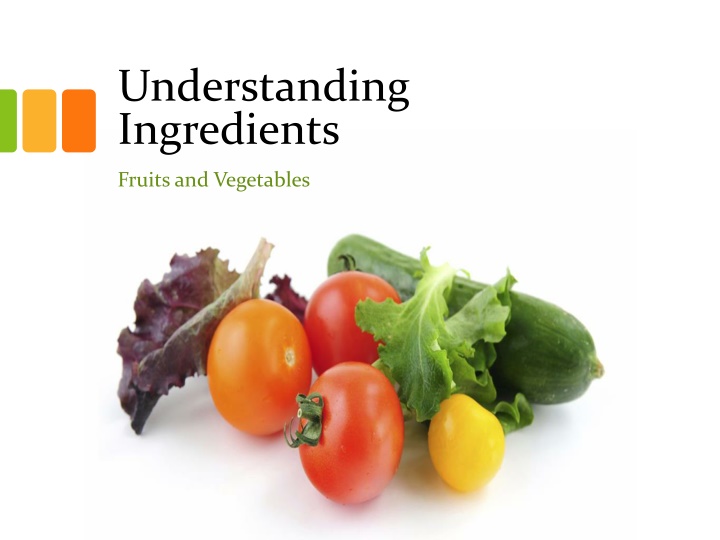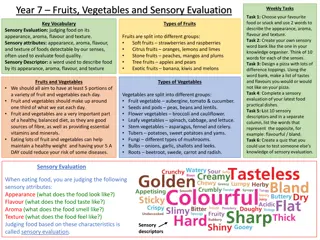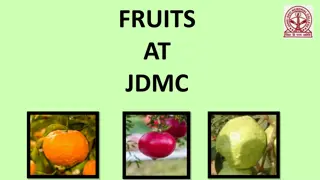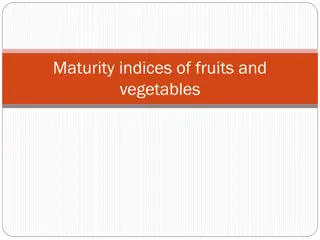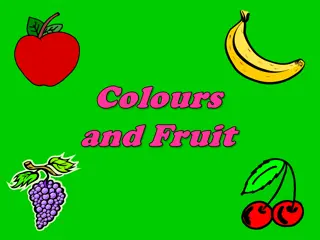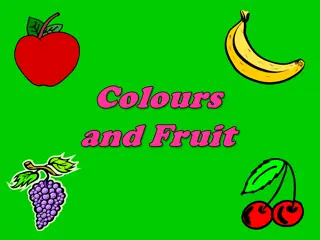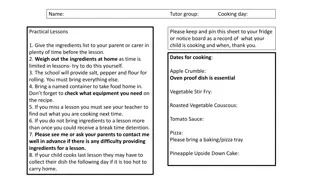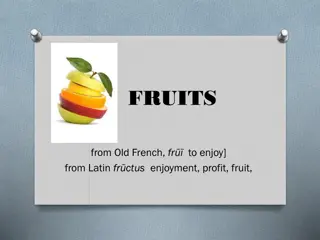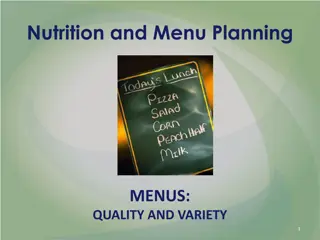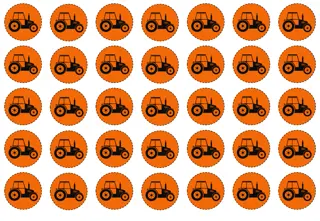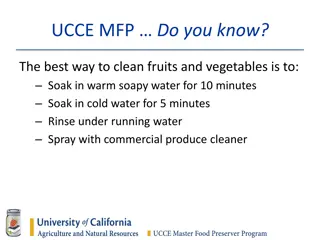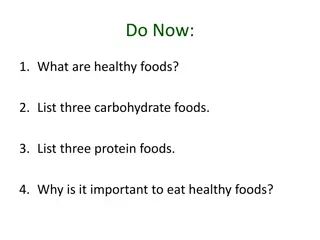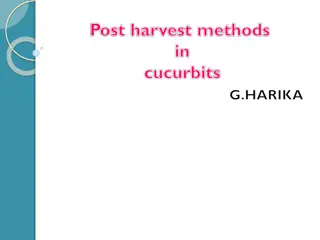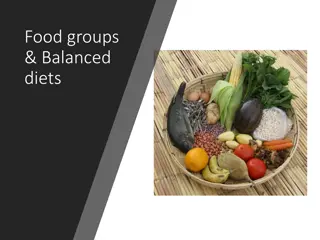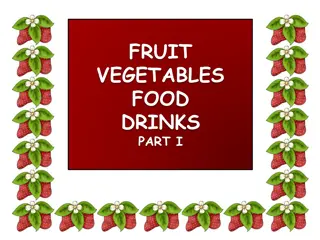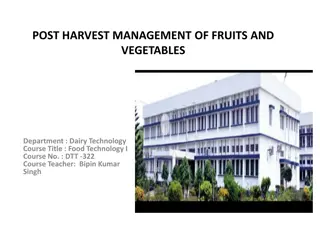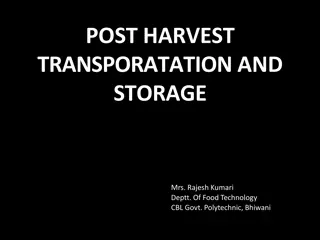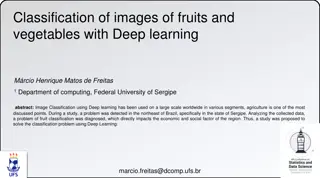Understanding Ingredients: Fruits and Vegetables Classification
Explore the types of vegetables and fruits, their structures, nutritive value, choice, storage, and uses in cooking. Learn about fresh produce versus processed products, and the classification based on the edible parts of plants.
Download Presentation

Please find below an Image/Link to download the presentation.
The content on the website is provided AS IS for your information and personal use only. It may not be sold, licensed, or shared on other websites without obtaining consent from the author.If you encounter any issues during the download, it is possible that the publisher has removed the file from their server.
You are allowed to download the files provided on this website for personal or commercial use, subject to the condition that they are used lawfully. All files are the property of their respective owners.
The content on the website is provided AS IS for your information and personal use only. It may not be sold, licensed, or shared on other websites without obtaining consent from the author.
E N D
Presentation Transcript
Understanding Ingredients Fruits and Vegetables
Topics Types of Vegetables and Fruits Structures of Vegetables and Fruits Nutritive Value of Vegetables and Fruits Choice and Storage of Vegetables and Fruits Uses of Vegetables and Fruits in Cooking / Diet Food and Nutrition Labelling of Vegetables and Fruits 2
Types of Vegetables and Fruits 3
Types of Vegetables and Fruits From food processing point of view, fruits and vegetables can be classified into two types: Fresh produce Food additives are not used Product are of natural qualities at its natural state They are perish in high rate Processed product Treated and often with food additives Subjected to alternation in terms of quality compared to its natural state Longer shelf life Available at any time of the year Quick and easy to cook e.g. frozen vegetables, canned fruits, dried vegetables/fruits, preserved vegetables, candied fruits 4
Types of Vegetables Vegetables are the edible portion of plant eaten with (or as) the main course Vegetables can be classified based on the part of the plant that is eaten Different types of vegetables have different food values 5
Classification based on the edible parts of plant Fruit the mature ovaries with seeds, also include vegetable fruits (in botany), e.g. tomato, cucumber and pepper Seed and pod seed are in fruits or pods, e.g. string beans and green peas Flower clusters of stem, e.g. broccoli and cauliflower Leaf typically thin and flattened part, e.g. spinach and lettuce 6
Classification based on the edible parts of plant Stem above ground axis that support the flower, leaf, and fruit, e.g. celery and asparagus Bulb a short underground stem with fleshy leaves that store food for adverse condition, e.g. onion and garlic Tuber enlarged underground structure used as storage for nutrients, e.g. potato and taro Root usually underground, it absorbs water and inorganic nutrients, e.g. carrot and turnip 7
Types of Fruit Botanically, fruits are the mature ovaries of plants with their seeds. Therefore, this definition includes all grains, legumes, nuts and seeds, and common vegetable-fruits such as cucumbers, olives, peppers, and tomatoes. When defined and considered in a culinary role, fruit is the fleshy part of a plant, usually eaten alone or served as a dessert. Fruits are high in organic acids and sugar higher than vegetables. 8
Types of Fruit Common classification of fruits: Berries Citrus fruits Grapes Melons Pome fruits Stone fruits Tropical and exotic fruits 9
Types of Fruit Berries a small sweet-tart flesh packed into a thin skin, e.g. strawberries, raspberries, blueberries Citrus fruits notable for their fragrance and juice content, e.g. orange, lemon, grapefruit, pomelo Grapes very versatile, e.g. red grapes, white grapes Melons grow on long vines, e.g. water melon, honeydew, cantaloupe 10
Types of Fruit Pome fruits grows on a tree, e.g. pear, apple Stone fruits contains a pit in the center, e.g. plum, cherry, prune Tropical and exotic fruits native to tropical and subtropical climates, they are called exotic because they are not readily available, e.g. mango, passion fruit, papaya, durian, star fruit 11
Structures of Vegetables and Fruits 12
Structures of Vegetables and Fruits Plant cells are primarily made of soft and succulent cells that are bounded by cell wall. In younger plants, cell wall is made of cellulose, hemicellulose, and pectic substances including pectin. Older, more mature plants have a secondary cell wall composed of lignin which is thick, tough, and fibrous. When the wall is firm, the original shape and texture of the cell are maintained. However, when the wall is destroyed (by cutting, dehydration or cooking), it breaks and spills its contents into the surrounding environment. Thus, water, sugars, or water-soluble vitamins of a cell may be lost. 13
Structures of Vegetables and Fruits Cell wall, contains cellulose, hemicellulose, pectic substances, and lignin Plasma membrane Mitochondria Ribosomes Chloroplast Endoplasmic reticulum Vacuole, holds water and provide crispy texture to vegetable Nucleus Drawing of a plant cell 14
Nutritive Value of Vegetables and Fruits 15
Nutritive Value of Vegetables and Fruits All vegetables and fruits provide dietary fibre and water Green vegetables are the main source of vitamin C Green, orange, yellow and red vegetables provide vitamin A Dark green vegetables provide calcium and iron Root and tuber vegetables contain starch Bulb vegetables contain sugar Fruits are good source of vitamins and minerals Fat is low in the majority of fruits and vegetables 16
Nutritive Value of Vegetables and Fruits Apart from nutrients, there are continual researches showing that non-nutrient substances can bring beneficial effects to health by their: antioxidant properties (beta-carotene, vitamin C, and vitamin E) anticarcinogenic properties The Department of Health launched a territory-wide healthy diet campaign, titled "2 plus 3 A Day" in June 2005. The campaign promotes the consumption of at least two servings of fruit and three servings of vegetables every day as part of a balanced diet in order to promote optimal health. 17
Choice and Storage of Vegetables and Fruits 18
Choice and Storage of Vegetables When buying fresh vegetables, check these characteristics: Ripeness - If the vegetables are not ripe when they are purchased, they will have poor texture and flavour Colour and texture - Vegetables should have a bright, characteristic colour and a crisp texture - Colour is the key to nutrition, especially for vitamin A content Shape - Misshapen vegetables may be poor in texture and flavour Size - Extra-large vegetables may be overripe, coarse, and have poor flavour - Extremely small ones tend to be immature and have poor flavour, too - Vegetables should feel heavy in relation to their size 19
Choice and Storage of Vegetables Keep green and salad vegetables crisp and fresh at the bottom vegetable drawer of a refrigerator Keep root and bulb vegetables in dry, ventilated, and dark place In some plants, e.g. potatoes sugars increase and starch decreases when stored in refrigerator, leading to flavour and texture quality loss 20
Choice and Storage of Fruits When buying fresh fruits, check these characteristics: The quality of fresh fruit depends on its maturity and ripeness Maturity means fruit has reached its full size Ripeness refers to how ready it is to eat Choose fruit which has a good colour, is firm and is not damaged Keep fruit cool and crisp in the refrigerator Most fruits are climate-dependent when they are grown Fruit that are grown in tropical area should be stored at room temperature instead of a refrigerator, otherwise they become soft and gelatinous 21
Uses of Vegetables and Fruits in Cooking / Diet 22
Uses of Vegetables in Cooking / Diet Vegetables are the edible portion of plant eaten with (or as) the main course Vegetables may be consumed raw or as appetizer, e.g. salad vegetables and Chinese cucumber salad They can also be made ready for consumption by methods such as baking, boiling, frying, pressure-cooking, blanching, stir-frying, and so forth, e.g.: Baked vegetables in Portuguese sauce Minestrone Onion rings Carrots in stewed meat dish Blanched choi sum Stir-fried mixed vegetables with garlic 23
Uses of Vegetables in Cooking / Diet Soup/appetizer e.g. Cream of Mushroom Soup, Borscht, Green Salad, Sweet Corn and Bean Curd Soup Main course (in particular for vegetarians) e.g. Cabbage Roll, Stir-fried Assorted Vegetables ( ) Side dish of main course in western cuisine Snack e.g. Potato Cakes, Deep Fried Stuffed Eggplant 24
Uses of Fruits in Cooking / Diet Fruit is usually eaten alone Fruit can be used to prepare: Breakfast e.g. fresh fruits, fruits in yoghurt, stewed fruits Soup e.g. Sour Cherry Soup, Papaya Soup Main course e.g. Pork Chop with Apple Sauce, Deep Fried Spareribs with Strawberry Dessert e.g. Apple Pie, Banana Fritters, Fruits in Jelly, Fruit Salad, Summer Pudding Bakery products e.g. cakes, biscuits, pastries and bread (e.g. Cookies with Raisins, Fruit Cake, Pineapple Tart, Danish pastry with Apricot, Banana Bread) Beverage e.g. smoothies, milk shakes, fruit juice Preserve e.g. jam, chutney, marmalade, lemon curd 25
Food and Nutrition Labelling of Vegetables and Fruits 26
Food and Nutrition Labelling of Vegetables and Fruits Vegetables and fruits that are not sold as prepackaged products in Hong Kong, is not bound to follow the nutrition labelling regulation in Hong Kong 27
Food and Nutrition Labelling of Vegetables and Fruits Organic Vegetables and Fruits Foods labelled organic must be grown without the use of Chemical pesticides Herbicides Fertilisers There must verifiable records of the system of production Organic products must be 95% organically produced Pesticide residue would certainly be lowered or nonexistent 28
Food and Nutrition Labelling of Vegetables and Fruits Organic Vegetables and Fruits Bacterial counts of organically grown plant material may be higher than conventionally grown foods There is no evidence that organically grown foods are higher in nutrient content than conventionally grown foods In Hong Kong, the Hong Kong Organic Resource Center (HKORC) had launched its independent organic certification service for organic farmers and organic food processors There is currently no legal requirement for organic foods 29
Food and Nutrition Labelling of Vegetables and Fruits Green Foods Green Food project of China is launched to enhance food quality and safety, to promote consumer's health, and to protect agricultural bio-environment for sustainable development Green Food Certification Standards is the transition between turning conventional farming to organic farming 30
References Provost, J., Kelly, B., Bodwin, J., & Wallert, M. (2016). The Science of Cooking. John Wiley & Sons. Vickie A. Vaclavik, Elizabeth W. Christian. Essentials of food science. New York, NY: Springer, c2008. Department of Health - Press Release (27 August 2005). Hong Kong Organic Resource Centre 31
